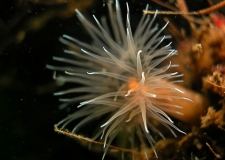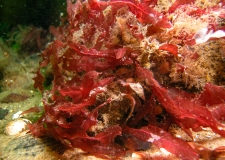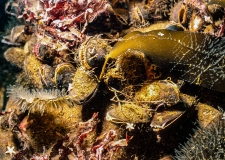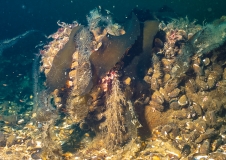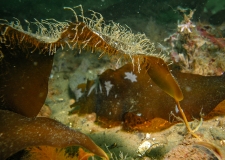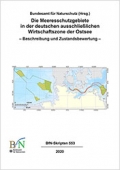The Kadet Trench Nature Conservation Area
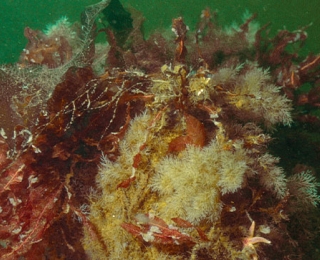
Facts Kadet Trench Nature Conservation Area
|
Natura 2000 site placed under national protection as an NCA in 2017 |
||
|
Fact sheet |
HD site |
|
|
Habitat types |
Reefs |
approx. 23 km² |
|
Species/Numbers |
Harbour porpoise (Phocoena phocoena) |
Most important migration and feeding area |
Important characteristics of the Nature Conservation Area
The reef areas in the Nature Conservation Area are of high ecological value and have important functions as stepping stones. The structural diversity results in high species-richness and abundance of numerous fish species. For harbour porpoises, the trench system has an important function as migration corridor between the central Baltic Sea and the Belt Sea.
The occurrence of habitat type reefs was the main differentiating factor in determining the protected area with water depths of 18 m to 32 m. From the Darss Sill several reefs reach out into the actual trench. These reefs are of great biodiversity importance for the Kadet Trench and important stepping stones for the recolonisation of the surrounding sea areas after oxygen deficiency events. A characteristic feature is the growth of macroalgae and blue mussels (Mytilus edulis) on the glacial boulder fields. Up to a depth of 18 m, the boulder reefs are overgrown with brown algae, above all sugar kelp (Laminaria saccharina). Furthermore, red algae are present at depths of up to 24 m. This occurrence of macrophytes in such depths is unusual for the southern Baltic Sea and requires constantly good light and oxygen conditions. Blue mussels are widely distributed with very dense growth on the boulders.
The special ecological value of the protected area is primarily attributable to the high structural diversity of the reefs in various slope locations and water depths. This and the relatively high salinity in parts enable the colonisation by a very species-rich benthic fauna with a very high number of Red List species. The good food availability and the many spawning and hiding places ensure a great abundance of fish in the NCA, which in turn attracts marine mammals and various seabirds.
Unfortunately, the conservation status of the reefs still shows a medium deficiency in the conservation degree. Eutrophication is the strongest burden for the habitat type reefs in the Kadet Trench NCA. Depending on the depth zone, the reef areas are partly covered by organic material, partly by annual algae, whereas the boulders at greater depths are covered by sulphur bacteria – see site description of the Baltic Sea NCA (Script 553).
Data from a porpoise click detector (POD), an underwater microphone recording harbour porpoises orientation sounds, reveal that harbour porpoises (Phocoena phocoena) frequently use the Kadet Trench. They are regularly found in the protected area and the bordering waters or swim through the area while migrating between the central and the western Baltic Sea. The Kadet Trench is very important, especially for the harbour porpoise population of the central Baltic Sea, which still consists of only about 500 individuals and is threatened with extinction. In late autumn and winter, individuals of this population migrate from the central Baltic Sea up to here. Detailed information can be found in the BfN's interactive map application.
A part of the population of the western Baltic Sea and the Belt Sea, currently estimated to be up to 40,000 animals (SCANS II results), also uses the NCA as a migration route. Harbour porpoises from this population partly migrate in spring with their calves to more easterly located waters and return from November onwards to the westerly located areas. The Kadet Trench NCA is an important migration and rearing area for harbour porpoises.
After numerous nature conservation measures, the grey seal population is finally growing again along the German Baltic Sea coast. The abundance of fish in the Kadet Trench is also beneficial for these seals, which are also sighted in the NCA.
The conservation targets and conservation objectives for the Kadet Trench NCA result from §3 of the Protected Area Ordinance (NSGKdrV). They include, in particular, the maintenance and restoration of:
- The specific ecological functions, biodiversity and natural hydro- and morphodynamics of the area
- The undisturbed exchange of water from North Sea and Baltic Sea as well as the connection and stepping-stone function for the ecosystems of the western and central Baltic Sea
- A favourable conservation status of the habitat type "reefs" (Code 1170) with the characteristic and endangered ecological communities and species
- A favourable conservation status of the HD species harbour porpoise and its habitats (e.g. through ASCOBANS Recovery Plan for Harbour Porpoises in the Baltic Sea).
There is intensive shipping traffic in the Kadet Trench NCA. A traffic separation scheme extends over approximately the whole width of the protected area (about 90% of the area). The mean density of shipping traffic is between 30 and 40 ships per km² and day (predominantly cargo ships, but also ferries). The high densities of shipping traffic have negative effects, especially on the harbour porpoises which react very sensitively to underwater noise. Seabirds that are sensitive to disturbances, e.g. divers or various sea ducks, avoid such strongly frequented areas, although they would find much food here.
Shipping traffic regulations can only be agreed at an international level by the International Maritime Organisation (IMO). Possible protection measures could be, for example, a reduction in the noise from ships through the deployment of quieter ship propulsion systems or temporally or spatially regulated speed limits.
Recreational fishing could be regulated
Recreational fishing regulations were implemented when the Protected Area Ordinances came into effect. In the central part of the NCA, there is thus an area of about 30 km² that is closed to recreational fishing from 1 February to 31 May. Another slightly larger area of about 40 km² is closed all year. The important and ecologically especially valuable reef areas of the NCA, for example, are located in the regulatory zones.
Commercial fishing regulations can only be issued within the framework of the EU's Common Fisheries Policy (CFP). The proposed measures are currently going through complicated national and European agreement processes.

